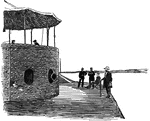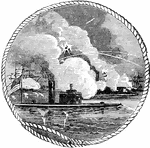Clipart tagged: ‘Merrimac’

Destruction of Merrimac
"Destruction of the Confederate ironclad steamer Merrimac, blown up by its commander, on the…

Monitor
Navy soldiers on the deck of the Monitor, a warship famous for the battle with the Merrimac.

Second Naval Battle
"Second naval battle in Hampton Roads- fight between the Federal ironclad Monitor, of two guns,…


